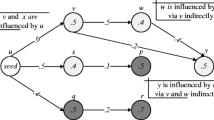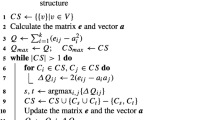Abstract
Influence propagation has been widely studied in social networks recently. Most of these existing work mainly focuses on the individual influence or the seed set influence. However, a large range of real world applications are related with the influence from communities. In this paper, we argue that the specific structure of community makes the influence propagation from a community different from previous influence propagation from an individual or a seed set. Inspired by the charged system in the physic, a new community influence propagation model is built, which provides a natural description about the process of influence propagation and explains why the influence makes communities expand. Based on this physical model, we define the community expansion problem. And two objective functions are proposed for choosing proper candidates to enlarge a community, taking into account the cost and benefit. Then a linear programming approach is designed to maximize those two objective functions. To validate our ideas and algorithm, we construct experiments on three real-world networks. The results demonstrate that our model and algorithm are effective in choosing proper candidates for expanding a community, comparing to other two algorithms.














Similar content being viewed by others
References
Aggarwal CC (2011) An introduction to social network data analytics. Springer, Berlin
Aggarwal CC, Yu P (2005) Online analysis of community evolution in data streams. In Proceedings of the SIAM international conference on data mining (SDM 2005), pp 56–67
Asur S, Parthasarathy S, Ucar D (2009) An event-based framework for characterizing the evolutionary behavior of interaction graphs. ACM Trans Knowl Discov Data (TKDD) 3(4):16
Apostolopoulos T, Vlachos A (2010) Application of the firefly algorithm for solving the economic emissions load dispatch problem. Int J Combin 2011
Backstrom L, Huttenlocher D, Kleinberg J, Lan X (2006) Group formation in large social networks: membership, growth, and evolution. In Proceedings of the 12th ACM SIGKDD international conference on knowledge discovery and data mining, ACM, pp 44–54
Blondel VD, Guillaume J-L, Lambiotte R, Lefebvre E (2008) Fast unfolding of communities in large networks. J Stat Mech Theory Exp 2008(10):P10008
Chakrabarti D, Kumar R, Tomkins A (2006) Evolutionary clustering. In Proceedings of the 12th ACM SIGKDD international conference on knowledge discovery and data mining, ACM. pp 554–560
Domingos P, Richardson M (2001) Mining the network value of customers. In Proceedings of the seventh ACM SIGKDD international conference on knowledge discovery and data mining, ACM, pp 57–66
Goyal A, Bonchi F, Lakshmanan LVS (2010) Learning influence probabilities in social networks. In Proceedings of the Third ACM international conference on web search and data mining, ACM. pp 241–250
Hartline J, Mirrokni V, Sundararajan M (2008) Optimal marketing strategies over social networks. In Proceedings of the 17th international conference on world wide web, ACM, pp 189–198
Halliday D, Resnick R, Walker J (2010) Fundamentals of physics extended. Wiley.com
Kempe D, Kleinberg J, Tardos E (2003) Maximizing the spread of influence through a social network. In Proceedings of the 9th ACM SIGKDD international conference on knowledge discovery and data mining, ACM, pp 137–146
Leskovec J, Backstrom L, Kumar R, Tomkins A (2008) Microscopic evolution of social networks. In Proceedings of the 14th ACM SIGKDD international conference on knowledge discovery and data mining, ACM. pp 462–470
Leskovec J, Krause A, Guestrin C, Faloutsos C, VanBriesen J, Glance N (2007) Cost-effective outbreak detection in networks. In Proceedings of the 13th ACM SIGKDD international conference on knowledge discovery and data mining, pp 420–429
Lu Z, Fan L, Wu W, Thuraisingham B, Yang K (2014) Efficient influence spread estimation for influence maximization under the linear threshold model. Int J Combin
Leskovec J, Lada A (2007) The dynamics of viral marketing. ACM Trans Web (TWEB) 1(1):5
Nguyen NP, Dinh TN, Xuan Y, Thai MT (2011) Adaptive algorithms for detecting community structure in dynamic social networks. In Proceedings of the 30th IEEE international conference on computer communications (INFOCOM 2011), IEEE. pp 2282–2290
Richardson M, Domingos P (2002) Mining knowledge-sharing sites for viral marketing. In Proceedings of the eighth ACM SIGKDD international conference on knowledge discovery and data Mining, ACM, pp 61–70
Saito K, Nakano R, Kimura M (2008) Prediction of information diffusion probabilities for independent cascade model. In Knowledge-based intelligent information and engineering systems. Springer, Berlin, pp 67–75
Sun T, Chen W, Liu Z, Wang Y, Sun X, Zhang M, Lin C-Y (2011) Participation maximization based on social influence in online discussion forums, In Proceedings of the fifth international AAAI conference on weblogs and social media
Shimp TA (2013) Advertising promotion and other aspects of integrated marketing communications. Cengage Learn
Wang C, Chen W, Wang Y (2012) Scalable influence maximization for independent cascade model in large-scale social networks. Data Min Knowl Discov 25(3):545–576
Yanqing H, Chen H, Zhang P, Li M, Di Z, Fan Y (2008) Comparative definition of community and corresponding identifying algorithm. Phys Rev E 78(2):026121
Acknowledgments
This work was supported in part by the the US National Science Foundation (NSF) under Grant Nos. CNS-1016320, CCF-0829993 and CCF-0627233.
Author information
Authors and Affiliations
Corresponding author
Rights and permissions
About this article
Cite this article
Bi, Y., Wu, W., Zhu, Y. et al. A nature-inspired influence propagation model for the community expansion problem. J Comb Optim 28, 513–528 (2014). https://doi.org/10.1007/s10878-013-9686-9
Published:
Issue Date:
DOI: https://doi.org/10.1007/s10878-013-9686-9




